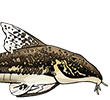Bifasciatus or something totally new?
-
cjerrom
- Posts: 15
- Joined: 01 Nov 2012, 23:57
- My cats species list: 54 (i:0, k:0)
- Location 2: Calgary, AB
Bifasciatus or something totally new?
Just getting these shipped to me and I will have better pics once they acclimatize but they were sold as green striped cories!! From Leticia, Colombia on the border with Brazil.
Any help identifying them (Bifasciatus?) would be greatly appreciated.
Curtis
Any help identifying them (Bifasciatus?) would be greatly appreciated.
Curtis
- bekateen
- Posts: 9544
- Joined: 09 Sep 2014, 17:50
- I've donated: $40.00!
- My articles: 4
- My images: 143
- My cats species list: 145 (i:105, k:33)
- My aquaria list: 41 (i:18)
- My BLogs: 44 (i:153, p:2558)
- My Wishlist: 36
- Spotted: 183
- Location 1: USA, California, Stockton
- Location 2: USA, California, Stockton
- Contact:
Re: Bifasciatus or something totally new?
Has this fish been dyed or stained? The color, esp. on the fins, doesn't look natural. (if not, maybe it's just an artifact of the photograph)
Find me on YouTube & Facebook: http://youtube.com/user/Bekateen1; https://www.facebook.com/Bekateen
Buying caves from https://plecocaves.com? Plecocaves sponsor Bekateen's Fishroom. Use coupon code bekateen for 15% off your order. Also, for you Swifties: Https://youtu.be/ZUKdhXL3NCw
- Dave Rinaldo
- Posts: 2178
- Joined: 31 Dec 2002, 10:49
- I've donated: $601.00!
- My images: 238
- My cats species list: 64 (i:0, k:0)
- Spotted: 97
- Location 2: Austin, Texas
Re: Bifasciatus or something totally new?
When first collected some Corydoras show more vivid colors than after collection. The pic looks like it was taken at the site of collection. So not stained/dyed.bekateen wrote:Has this fish been dyed or stained?
- bekateen
- Posts: 9544
- Joined: 09 Sep 2014, 17:50
- I've donated: $40.00!
- My articles: 4
- My images: 143
- My cats species list: 145 (i:105, k:33)
- My aquaria list: 41 (i:18)
- My BLogs: 44 (i:153, p:2558)
- My Wishlist: 36
- Spotted: 183
- Location 1: USA, California, Stockton
- Location 2: USA, California, Stockton
- Contact:
Re: Bifasciatus or something totally new?
I've seen pictures of that phenomenon before, but I never knew it could look this dramatic. Thanks Dave.Dave Rinaldo wrote:When first collected some Corydoras show more vivid colors than after collection. The pic looks like it was taken at the site of collection. So not stained/dyed.
Cheers,
Eric
Find me on YouTube & Facebook: http://youtube.com/user/Bekateen1; https://www.facebook.com/Bekateen
Buying caves from https://plecocaves.com? Plecocaves sponsor Bekateen's Fishroom. Use coupon code bekateen for 15% off your order. Also, for you Swifties: Https://youtu.be/ZUKdhXL3NCw
-
Karsten S.
- Posts: 609
- Joined: 26 May 2007, 22:35
- My images: 30
- Spotted: 20
- Location 1: Ludwigsburg - Germany
- Location 2: Ludwigsburg - Germany
Re: Bifasciatus or something totally new?
Hi,
this cory comes very close to C. bifasciatus, without your info about the origin I would not have much doubts.
But Laetitia is very far (IMHO too) away from Tapajós river system where C. bifaciatus originate.
I don't known any cory from Colombia which comes close to this fish.
Either it is a new cory very similar to C. bifasciatus or they had a long journey before arriving at Laetitia...
Any chance to find out more about the exact catching location ?
@Eric: The discussed phenomen is quite often even much more extreme especially in white water habitats. The problem is to catch this in pictures. Can you imagine that we could hardly distinguish C. arcuatus and C. leucomelas in the dip net in the first seconds after catching them ?!
At the first glance they both looked (colour pattern wise) like Brochis sp., only after a few minutes the "typical" pattern appeared...
Cheers,
this cory comes very close to C. bifasciatus, without your info about the origin I would not have much doubts.
But Laetitia is very far (IMHO too) away from Tapajós river system where C. bifaciatus originate.
I don't known any cory from Colombia which comes close to this fish.
Either it is a new cory very similar to C. bifasciatus or they had a long journey before arriving at Laetitia...
Any chance to find out more about the exact catching location ?
@Eric: The discussed phenomen is quite often even much more extreme especially in white water habitats. The problem is to catch this in pictures. Can you imagine that we could hardly distinguish C. arcuatus and C. leucomelas in the dip net in the first seconds after catching them ?!
At the first glance they both looked (colour pattern wise) like Brochis sp., only after a few minutes the "typical" pattern appeared...
Cheers,
--
Karsten
Karsten
- bekateen
- Posts: 9544
- Joined: 09 Sep 2014, 17:50
- I've donated: $40.00!
- My articles: 4
- My images: 143
- My cats species list: 145 (i:105, k:33)
- My aquaria list: 41 (i:18)
- My BLogs: 44 (i:153, p:2558)
- My Wishlist: 36
- Spotted: 183
- Location 1: USA, California, Stockton
- Location 2: USA, California, Stockton
- Contact:
Re: Bifasciatus or something totally new?
Thanks, @Karsten, for that example. On this issue, and without wishing to derail the current thread, I think that one day, if anyone ever figures out how to replicate these vivid natural colors with an effective special diet flake or water conditioner (or whatever else) which they can package and market, they will make some serious money! 
The fact that the color can disappear "within minutes" would indicate that it's not simply a special nutrient, although special nutrients might still be needed for the fish to have the ability to express the color.
Cheers, Eric
The fact that the color can disappear "within minutes" would indicate that it's not simply a special nutrient, although special nutrients might still be needed for the fish to have the ability to express the color.
Cheers, Eric
Find me on YouTube & Facebook: http://youtube.com/user/Bekateen1; https://www.facebook.com/Bekateen
Buying caves from https://plecocaves.com? Plecocaves sponsor Bekateen's Fishroom. Use coupon code bekateen for 15% off your order. Also, for you Swifties: Https://youtu.be/ZUKdhXL3NCw
-
cjerrom
- Posts: 15
- Joined: 01 Nov 2012, 23:57
- My cats species list: 54 (i:0, k:0)
- Location 2: Calgary, AB
Re: Bifasciatus or something totally new?
I love this - I will get him to ship me a small quantity of water and get my oil field buddies to chromatograph it to see what's in the water from the location! Could be as simple as trace minerals, pH and temp combo! I will post the pics once they arrive as well later after Christmas! Excellent site!!
- Coryman
- Expert
- Posts: 2119
- Joined: 30 Dec 2002, 19:06
- My articles: 12
- My catfish: 5
- My cats species list: 83 (i:3, k:0)
- My BLogs: 1 (i:0, p:46)
- Spotted: 194
- Location 1: Kidderminster UK
- Location 2: Kidderminster, UK
- Interests: Cory's, Loricariids, photography and more Cory's
- Contact:
Re: Bifasciatus or something totally new?
This is probably a new species. The vast distance between the type locality of C. bifasciatus and Leticia is one thing but the actual pattern is different, in C. bifasciatus the lower band runs along the intersection of the body scutes. Your fish shows the typical C. parallelus pattern, but with a saddle snout. Finding out the catch location would a bonus.
Ian
Ian
-
Karsten S.
- Posts: 609
- Joined: 26 May 2007, 22:35
- My images: 30
- Spotted: 20
- Location 1: Ludwigsburg - Germany
- Location 2: Ludwigsburg - Germany
Re: Bifasciatus or something totally new?
Hello Ian,
I disagree.
If you look at the paratype shown at CW your description fits.
But C. bifasciatus seems to be variable with respect of the position of the bands.
The holotype has the lower band exactly at the same position as the specimen shown here (well below the junction of the body scutes). However, I would agree that this variance is rather unusual within one species.
As Curtis has another species (CW101) that comes from the same region as C. bifasciatus I tend to believe that this is the real one...
Cheers,
I disagree.
If you look at the paratype shown at CW your description fits.
But C. bifasciatus seems to be variable with respect of the position of the bands.
The holotype has the lower band exactly at the same position as the specimen shown here (well below the junction of the body scutes). However, I would agree that this variance is rather unusual within one species.
As Curtis has another species (CW101) that comes from the same region as C. bifasciatus I tend to believe that this is the real one...
Cheers,
--
Karsten
Karsten
-
cjerrom
- Posts: 15
- Joined: 01 Nov 2012, 23:57
- My cats species list: 54 (i:0, k:0)
- Location 2: Calgary, AB
Re: Bifasciatus or something totally new?
Just as an update I will have the actual catch location as I just picked up 30 parallelus, 30 CW101 and this batch came from the Peru/Colombia border. The ones in the pictures came from Leticia,Colombia but I will have a catch location tomorrow/tonight once I finish buying from these natives as they want some Christmas cash!!
LDA105's anyone want some as I now own 35 of them from 3"-10" - dang it I am an addict now!
LDA105's anyone want some as I now own 35 of them from 3"-10" - dang it I am an addict now!
- bekateen
- Posts: 9544
- Joined: 09 Sep 2014, 17:50
- I've donated: $40.00!
- My articles: 4
- My images: 143
- My cats species list: 145 (i:105, k:33)
- My aquaria list: 41 (i:18)
- My BLogs: 44 (i:153, p:2558)
- My Wishlist: 36
- Spotted: 183
- Location 1: USA, California, Stockton
- Location 2: USA, California, Stockton
- Contact:
Re: Bifasciatus or something totally new?
Hi Curtis,cjerrom wrote:I love this - I will get him to ship me a small quantity of water and get my oil field buddies to chromatograph it to see what's in the water from the location! Could be as simple as trace minerals, pH and temp combo! I will post the pics once they arrive as well later after Christmas! Excellent site!!
Here's another ripple on the theme of wild fish having better colors than captive fish: Recently I bought some golden tetras () as open-water fish.As I read up on them, I discovered that they too lose color in captivity, particularly from generation to generation. This is because their natural "golden" color is due to the fact that wild individuals are often infected with a parasitic trematode worm. To defend themselves, the fish produce guanine in the skin, creating the shimmery golden color. Captive bred individuals are usually not infected with the parasite and thus have a lower guanine level in the skin and are more silvery than golden in color.
I couldn't find scientific resources about this phenomenon, but I read about it here:
- http://www.fishbase.org/summary/Hemigra ... dwayi.html
- http://www.thefishlist.net/profile.php?id=100
- http://animal-world.com/encyclo/fresh/c ... golden.php
Cheers, Eric
Find me on YouTube & Facebook: http://youtube.com/user/Bekateen1; https://www.facebook.com/Bekateen
Buying caves from https://plecocaves.com? Plecocaves sponsor Bekateen's Fishroom. Use coupon code bekateen for 15% off your order. Also, for you Swifties: Https://youtu.be/ZUKdhXL3NCw







